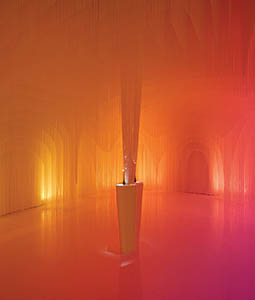Home > Highlighting JAPAN > Highlighting Japan July 2018 > The Evolution of Japonism
Highlighting JAPAN


Laurent Ghnassia Purveyor of Extraordinary Moments
Laurent Ghnassia’s Tokyo-based creative studio, La Boite, uses imaginative cultural events from exhibitions to luxe parties to market fashion brands, art and film ventures and even international charities in unforgettable ways. The studio’s work often incorporates elements of Japanese culture to create inspired events and venues.
Laurent Ghnassia wasn’t always in the art and culture business. He was once an economic researcher working in the banking industry, but the work left him cold. Interested in culture, he became a producer on a feature film that went to Cannes. “That was the only decision I made in my life—the only real chaotic decision that has had a lasting influence,” says Ghnassia. “The rest is a domino effect from that moment.”
After directing the Marseilles Film Festival and three years as art director for the fashion brand agnès b., Ghnassia met his future wife, actress Shinobu Terajima. In 2007 he decided to strike out on his own, and founded his Tokyo-based agency La Boite. Creating events for major brands, Ghnassia says they zoom out to the “eagle’s-eye view” to capture the macro elements they want to convey, and generate ideas from there. For a press event for the fashion brand Kenzo to welcome Italian designer Antonio Marras to Japan, for example, the company created an ethereal program inspired by the designer’s work, combining traditional Japanese elements such as a kabuki hanamichi runway, butoh dance and Japanese cuisine with more contemporary aspects.
Ghnassia says that having fresh eyes is an advantage. “I have a European background, de facto. Those are my roots. And I also have the influence of the Japanese philosophy and way of life.” He says he is privileged to be part of the Terajima family*, which in addition to his actress wife includes her actress mother as well as her father and brother, both kabuki actors. This connects him to a wealth of Japanese cultural heritage.
“Japan has the richness of immaterial heritage, and this immateriality makes it eternal,” he says, noting that although earthquakes, typhoons and other natural disasters have often decimated structures, traditions such as kabuki are kept alive by being passed down through generations.
“Inside me, of course, there is this mutation,” he adds, explaining that he perhaps notices the country’s charms more than someone long immersed in the culture, since the information is new. And an appreciation for that culture helps La Boite harness it. At an event held at beautiful Byodoin Temple in Kyoto, for example, they built on the history of the temple and the region, taking cues from The Tale of Genji, a court novel set in the area dating from the Heian period (794–1185), when Byodoin was established. The decor reflected elements from the text, and the kabuki actor Ebizo performed a scene from “Ujijujyo,” one of the last chapters of the novel.
“When we work on a venue, we need to pay respect to the place that’s welcoming us, and to be organic,” Ghnassia notes.
Ghnassia sees his work as “creating extra-ordinary moments thorough cultural elements to convey a story, to convey an identity.” By combining a deep respect and understanding for Japan with his innovative concepts, he hopes guests will leave somehow changed by those ephemeral episodes that transcend borders.
* Terajima family: currently represented by Ghnassia’s father-in-law, whose kabuki name is Onoe Kikugoro VII. The Terajima’s kabuki lineage can be traced back to the 1700s.
© 2009 Cabinet Office, Government of Japan







